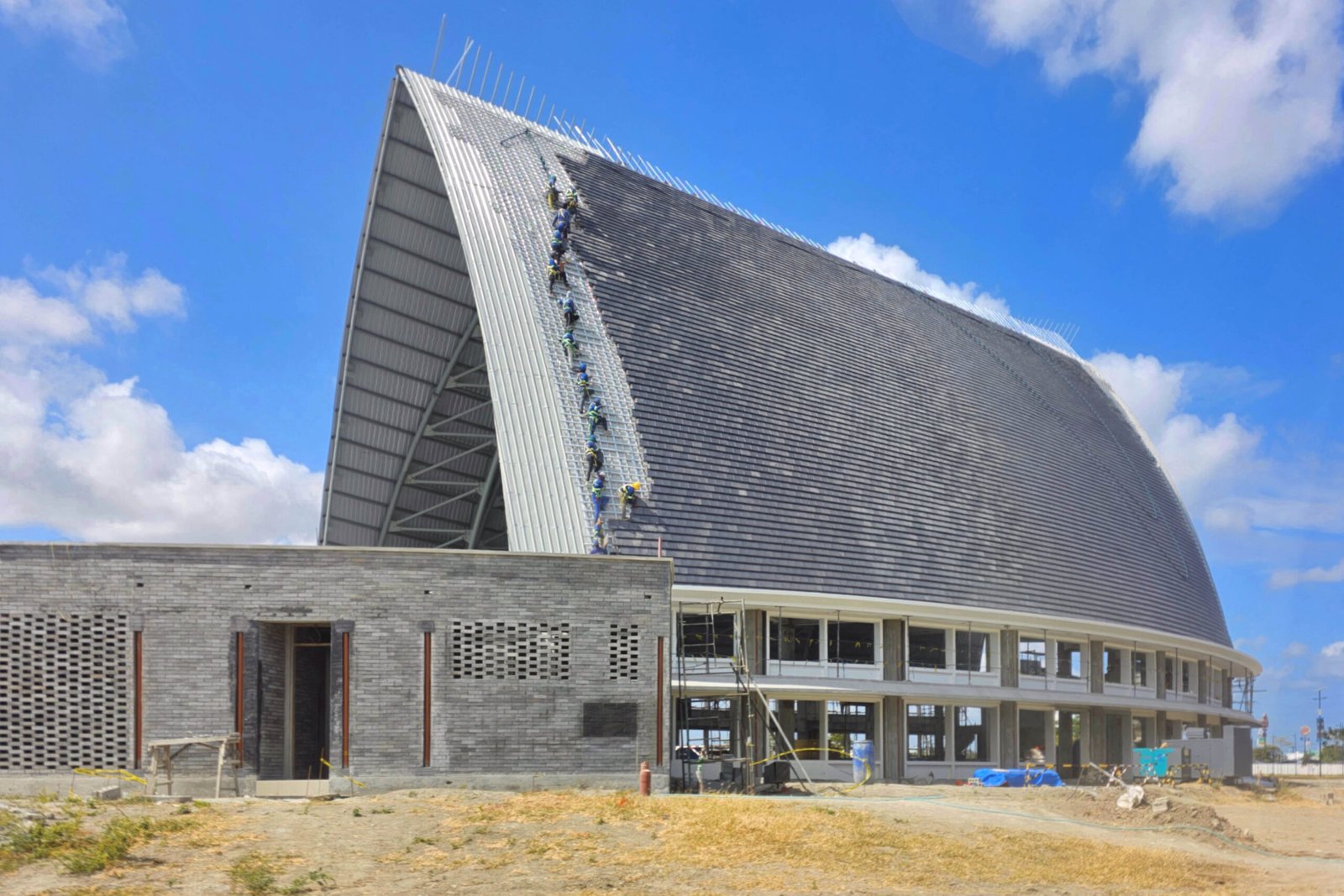Words Judith Torres
Images Patrick Kasingsing and Dominic Galicia Architects
(Evo City Church)

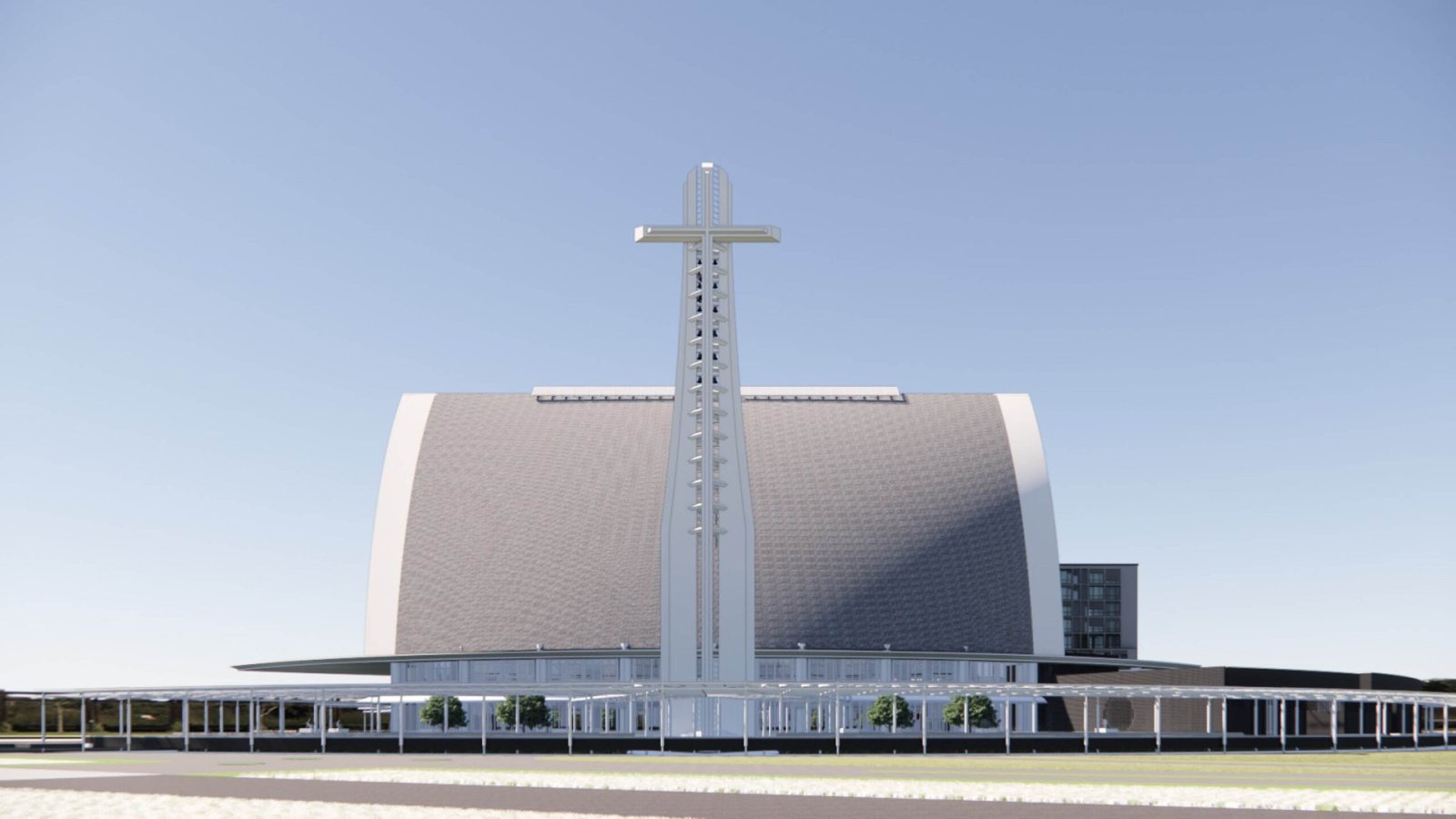
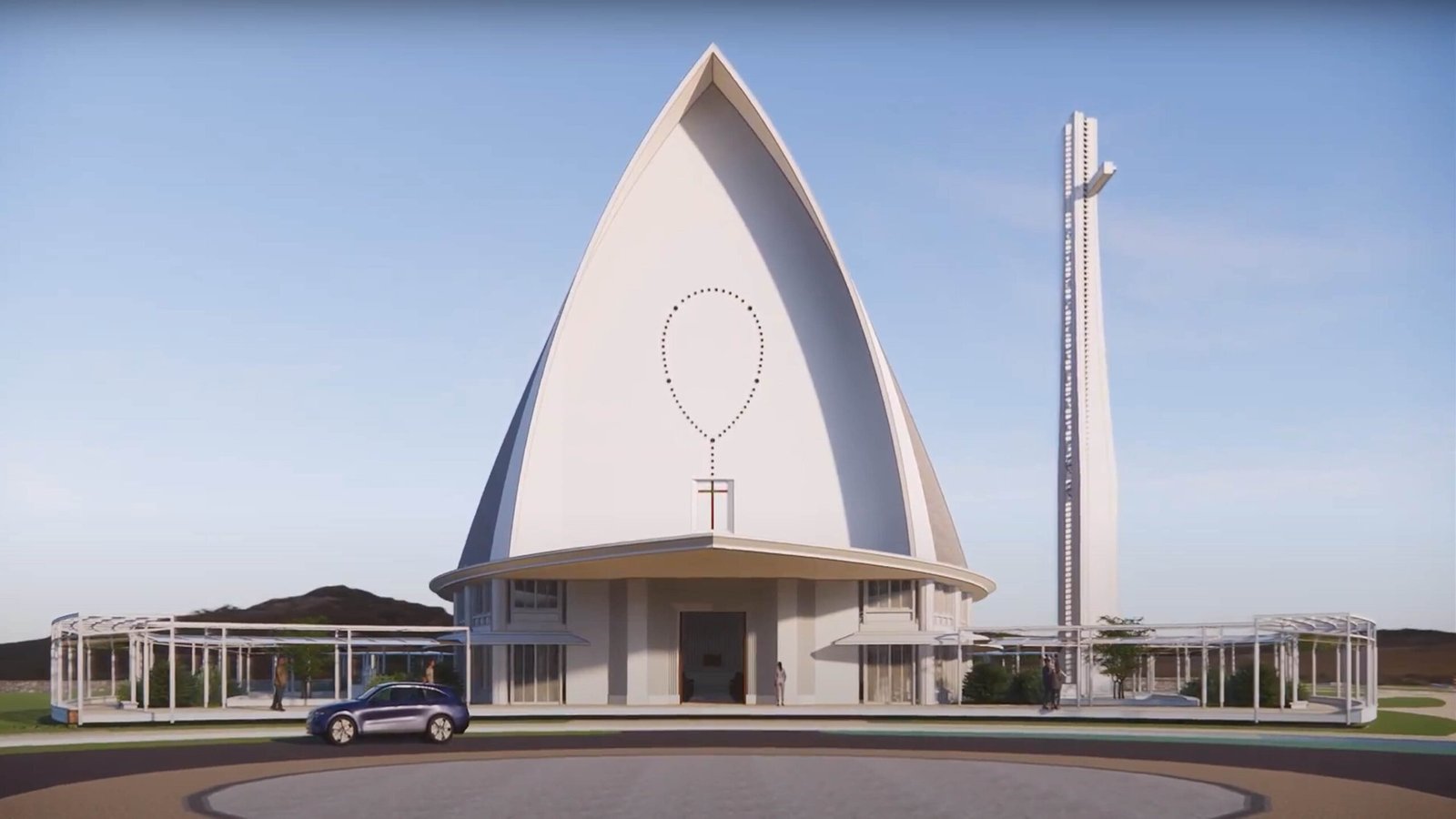
It’s a midsummer morning, one of the hottest and driest of the season. Donning our safety helmets, architect Dominic Galicia, Kanto chief Patrick Kasingsing (who is also taking photos), and I crunch our way over gravel and grass toward the entrance of Evo City Church. Anticipation fills the air as we approach the structure taking shape, a house of worship that promises to embody earnest prayer and the realization of heartfelt hopes.
The Approach: Symbolism and Form
The church site sits near the entrance of Evo City, a 200-hectare township being developed by Ayala Land subsidiary Alveo on Cavite’s main highway, Centennial Road. “The site itself is quite irregular,” Dominic Galicia begins, gesturing at the surroundings of the 19,000-square-meter plot, “which we organized by inscribing two overlapping circles inside it. The overlap results in a vesica piscis, a fish shape that informs many aspects of the design.”
The vesica piscis symbolizes the intersection of two worlds and was used by early Christians during Roman persecution to secretly identify each other. Galicia’s excitement is palpable as he describes how this ancient geometric form inspired the pointed form of the structure and its overarching design philosophy. This philosophy seeks to create a sacred space that embodies the convergence of the divine and the earthly, the spiritual and the temporal, through the integration of symbolic geometry and architectural elements.
We reach the framework of the 16-meter cantilevered canopy, another elegant outline derived from the vesica piscis, which also defines the shape of the church’s floor plan. “This canopy is the western tip of the fish, while the other tip is at the opposite end, forming the canopy of the sacristy (the room where clergy prepare for mass),” Galicia explains. “Half the plan is reflected in the height and shape of the elevation, creating a proportional relationship between the two.”
Later, when Galicia shows us site plans and elevations, we see that beyond the building’s silhouette, canopies, and floorplan, the church’s pointed interior arches, as well as its future garden walkways and trellised paths, would also echo the vesica piscis form.
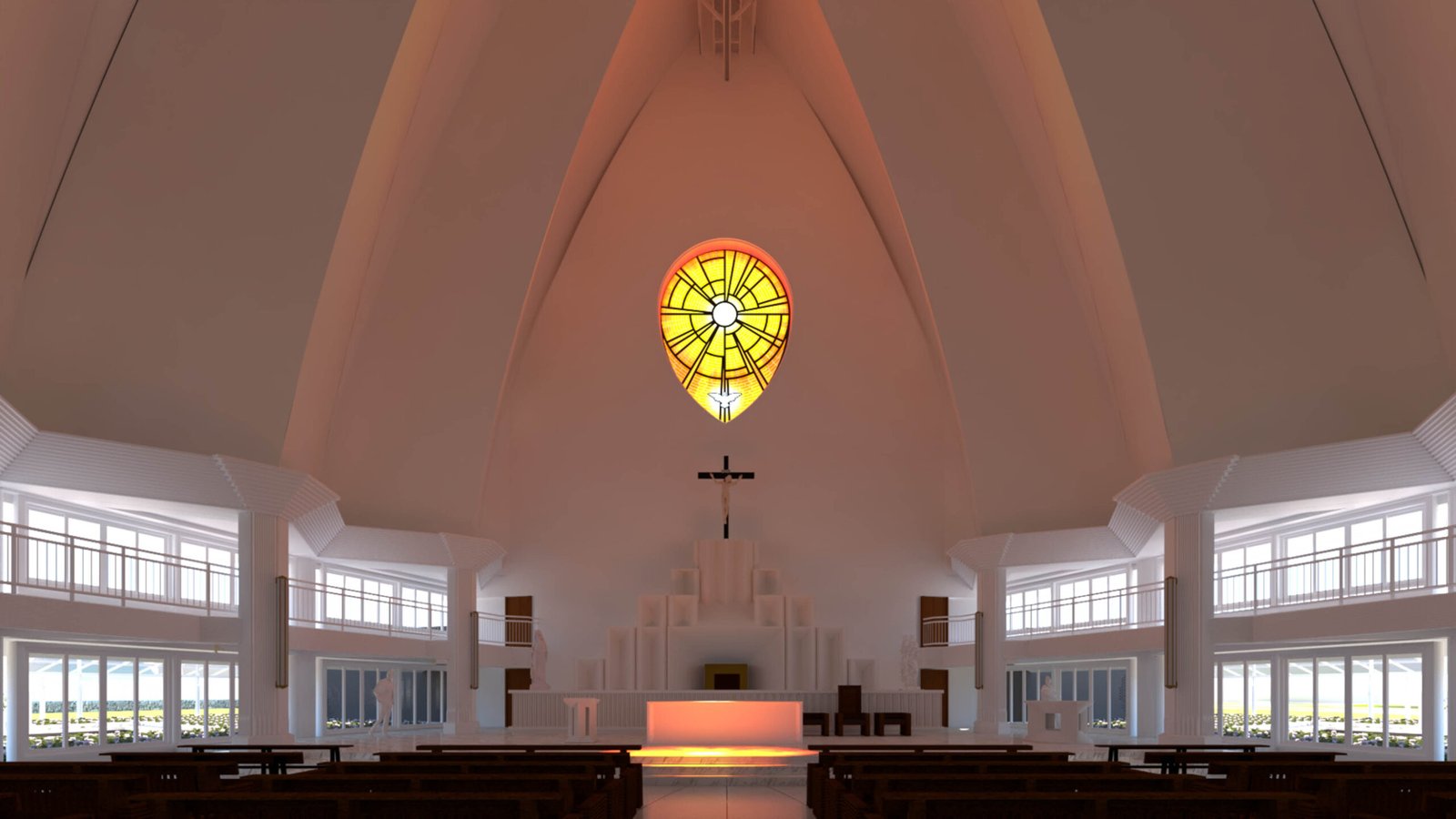

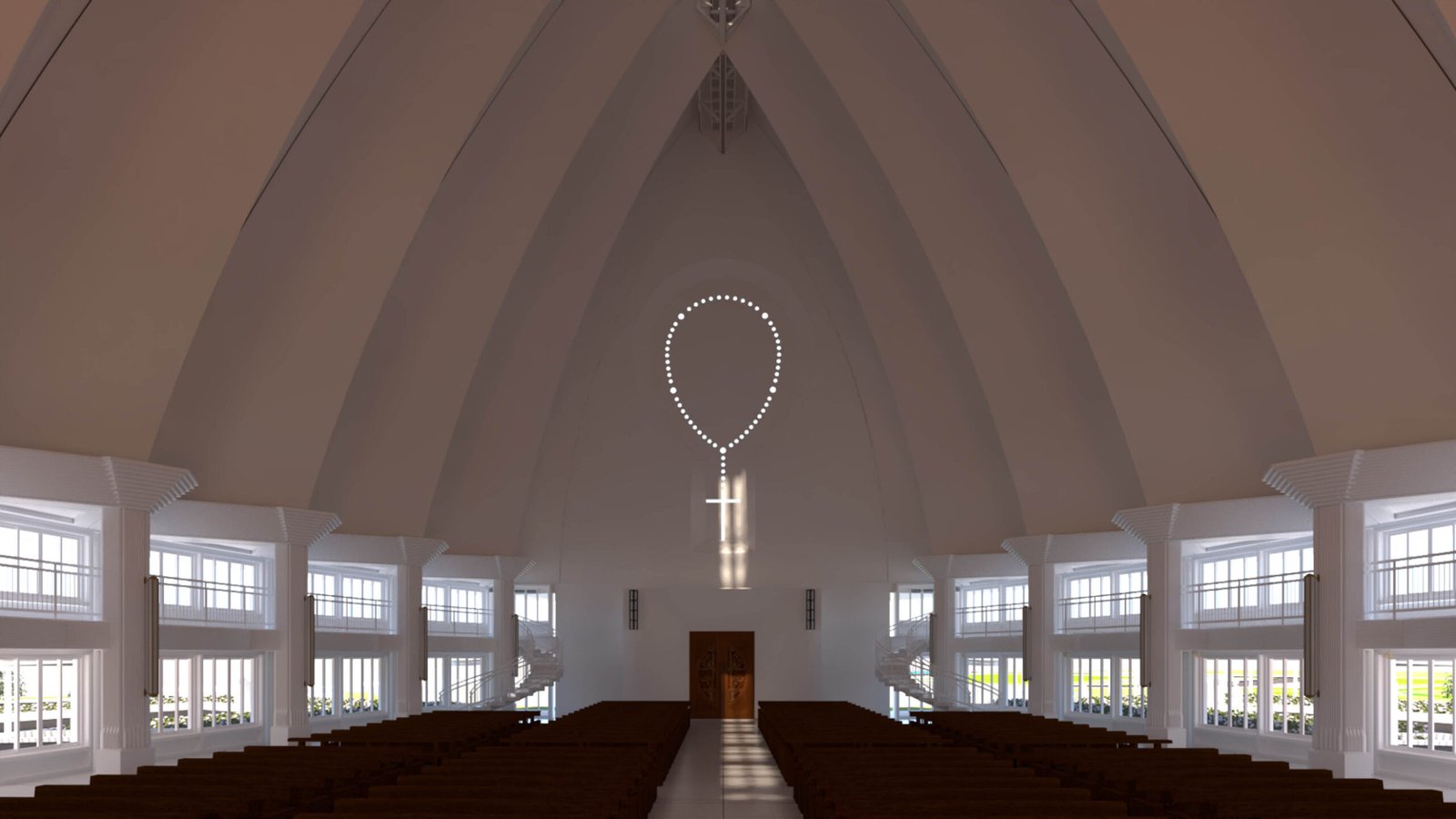

Architectural Vision and Collaboration
Dominic Galicia’s experience designing churches is vast. Each project reflects his scholarly approach and deep respect for liturgical symbolism. His designs reveal themselves slowly, with new meanings and forms discovered through repeated visits to the site.
Robert de Mesa, a key collaborator in Galicia’s firm, describes their working relationship: “My primary focus was executing Dom’s vision and refining the church’s design and details. Dom blends poetry with functionality and meticulous attention to detail, an approach that persisted from inception to construction. Our relationship thrived on constant communication, mutual trust, and dedication to preserving the design intent.”
Their complementary strengths—Galicia’s artistic vision and De Mesa’s technical focus—harmonized to execute the church’s design with creativity and precision.
Light As Divine Presence
“The first idea that came to us for this project was how to modulate the hot sun to animate the space,” Galicia says, shading his eyes against the ascendant sun and waving an arc across the sky. “The thing we least want—the hot afternoon sun—becomes a central feature. The church’s orientation to the West aligns with the entrance to Evo City, welcoming people arriving. In this way, the church stands as an expression of the promise of prayer and its fulfillment.”
The theme of promise and fulfilment, or prefiguration, was one we would see again and again as Galicia toured us through the construction site. Prefiguration is a theological concept in which events in the Old Testament are seen as foreshadowing events in the New Testament.
The liturgical symbolism of church doors facing West and the altar facing East is an age-old tradition. Entering from the West, one leaves behind the material world to approach the sacred. The altar faces East, towards the rising sun, symbolizing Christ’s resurrection and return.
Galicia elaborates on how the design builds on this liturgical symbolism: “The western sun hits the clear beveled glass rosary beads of the western wall—a call to pray. The eastern sunlight illuminates the stained glass above the altar, which shines on the crucifix, symbolizing, ‘Come in and pray, and I shall show you my son.'” Or, as the Biblical prophet Jeremiah says, “Call to me, and I shall answer you and tell you great and unsearchable things you do not know.”
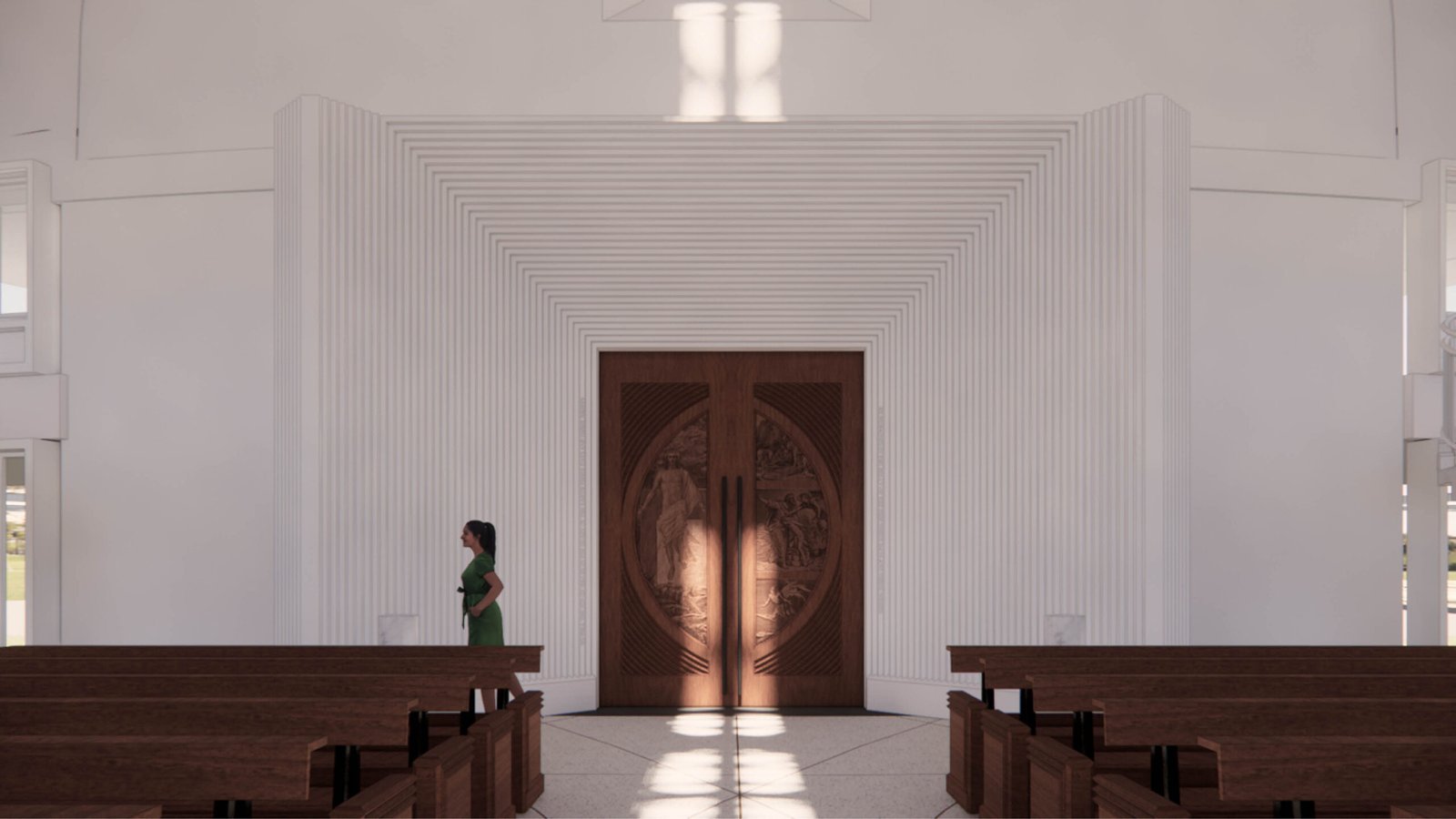

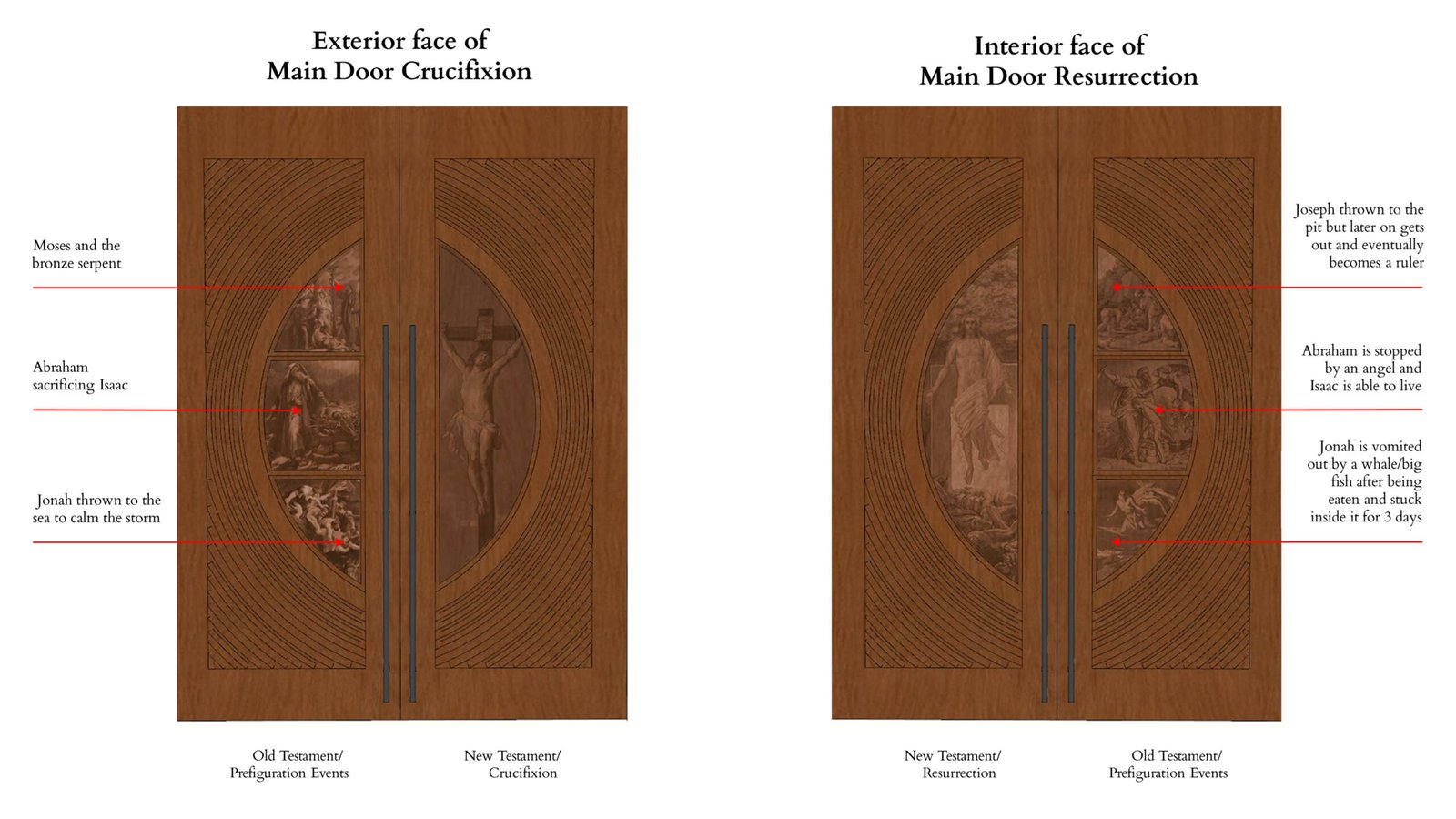


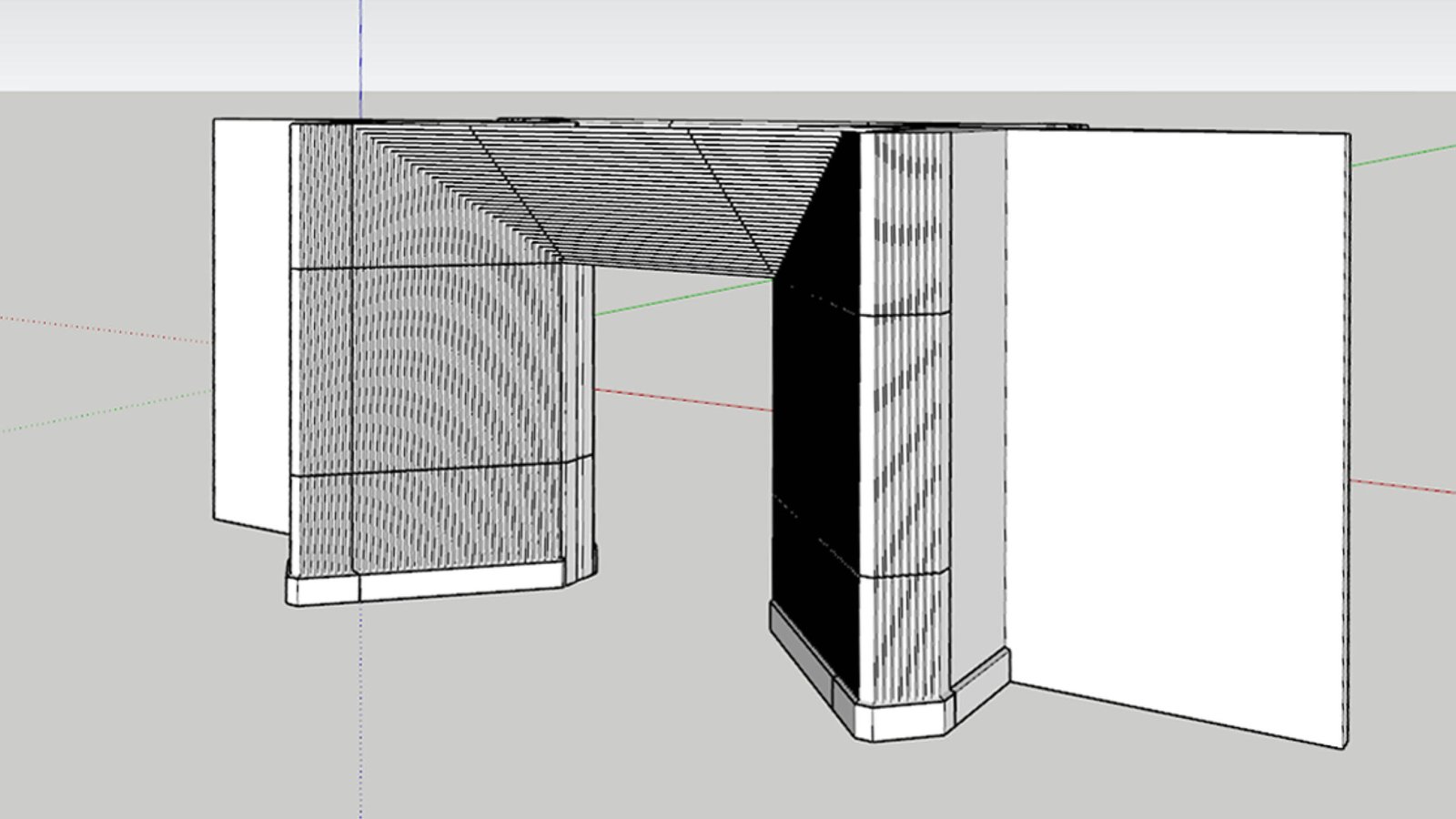

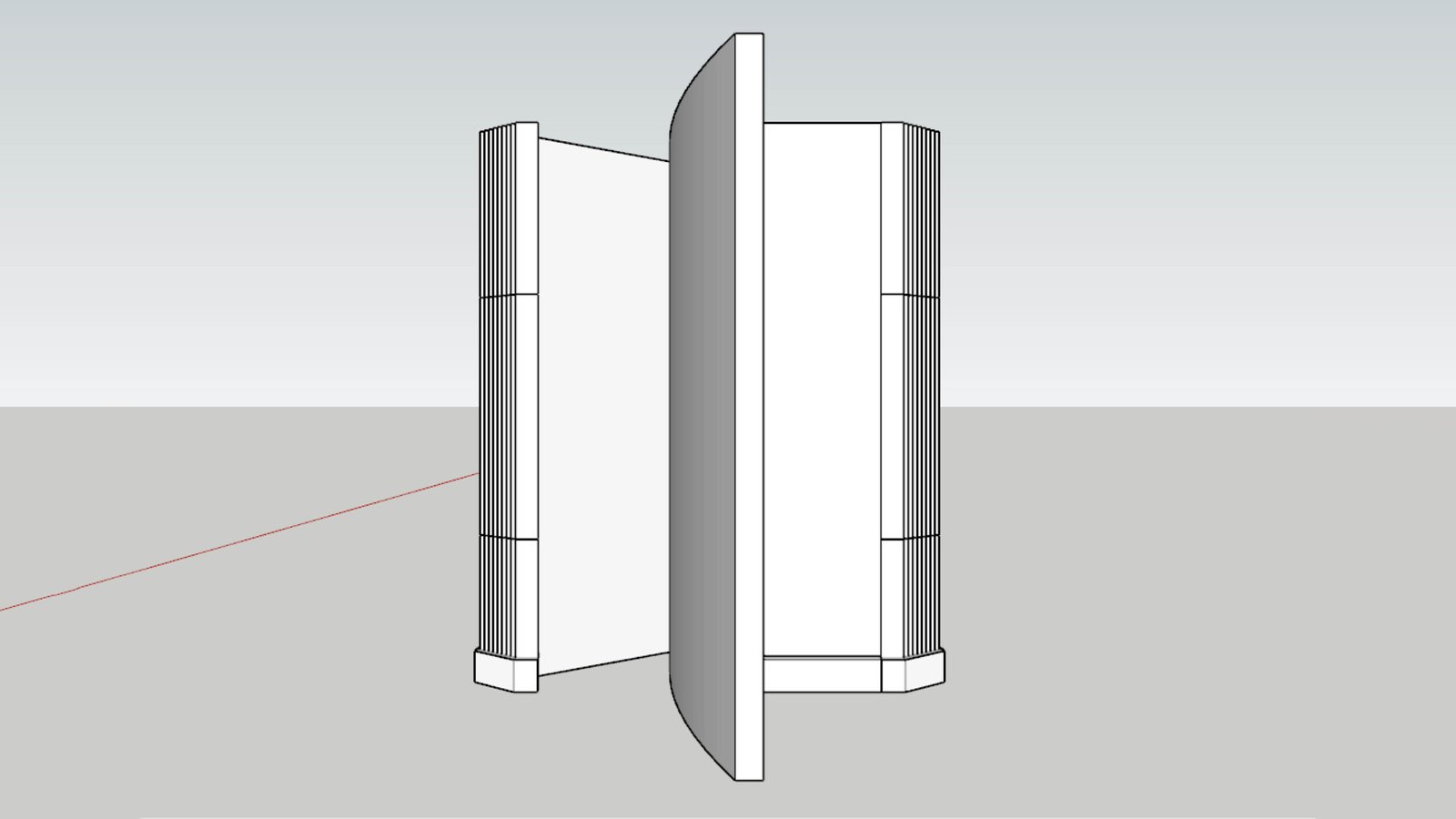

A massive GFRC portal by House of Precast frames the church doors and houses a 2 x 1.53-meter confessional on the left and right.
Entering the Sacred Space
Facing the large gap before us, Galicia holds both hands up as he elaborates on the doorway design. “This is where the main doors will be, adorned by carvings that speak to prefiguration—Old Testament events on the outside, New Testament on the inside. These door panels will feature stories like Moses and the bronze serpent, Abraham sacrificing Isaac, and Jonah in the whale, all foreshadowing the crucifixion.”
The Confessionals and the Columns
Inside the church, Dom indicates that confessionals will flank the central doorway. The placement of the confessionals at the entrance signifies reconciliation and purification, preparing the faithful to enter the sacred space with a cleansed spirit. A worker shows us the first batch of precast forms by House of Precast that just arrived. The stepped articulation for the central doorway that houses the confessionals is a nod to the influence of the modernist Italian architect Carlo Scarpa.
“These columns,” Galicia points out, “soar 26 meters high, though they’re curved. What excited us about these columns, which extend to rafters holding up the roof, is that each forms a triangle.” A triangle’s seismic stability is unmatched. But anticipating the triangle’s symbolism, I ask whether that was an architectural or engineering decision.
Dom laughs. “That’s the interesting thing, you know. The nature of a design decision, how it occurs conceptually, pragmatically, and poetically, you don’t know when one is pragmatism and when one is poetry. We wanted to create stability, an ambulatory, and something trinitarian. I don’t know which came first. Really, the confluence of how an idea generates, develops, evolves—that’s the story of how design becomes. That’s why time is of the essence, haha! You have to give it time.”
“For serendipity to work?”
“And for meanings to accrue.”
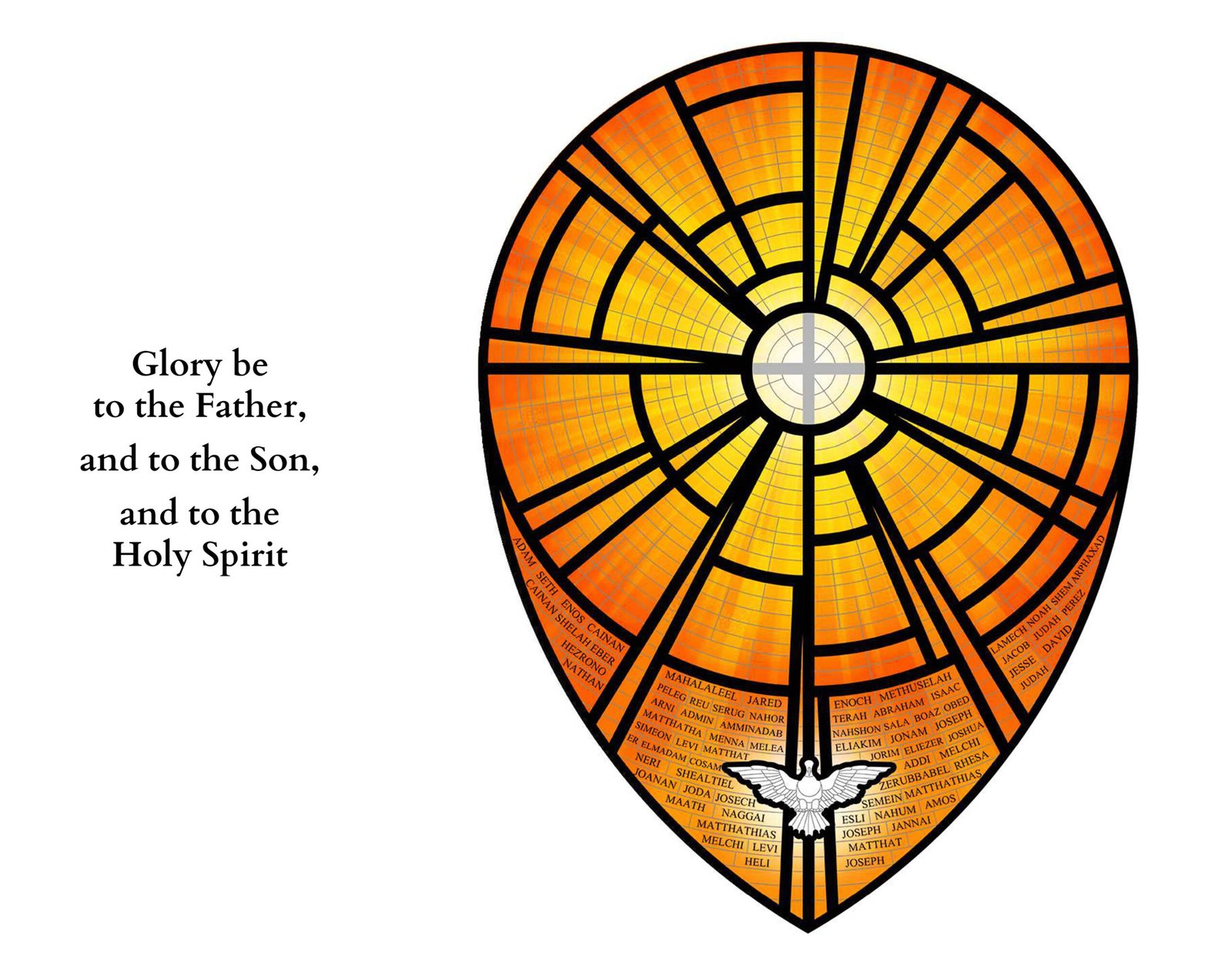

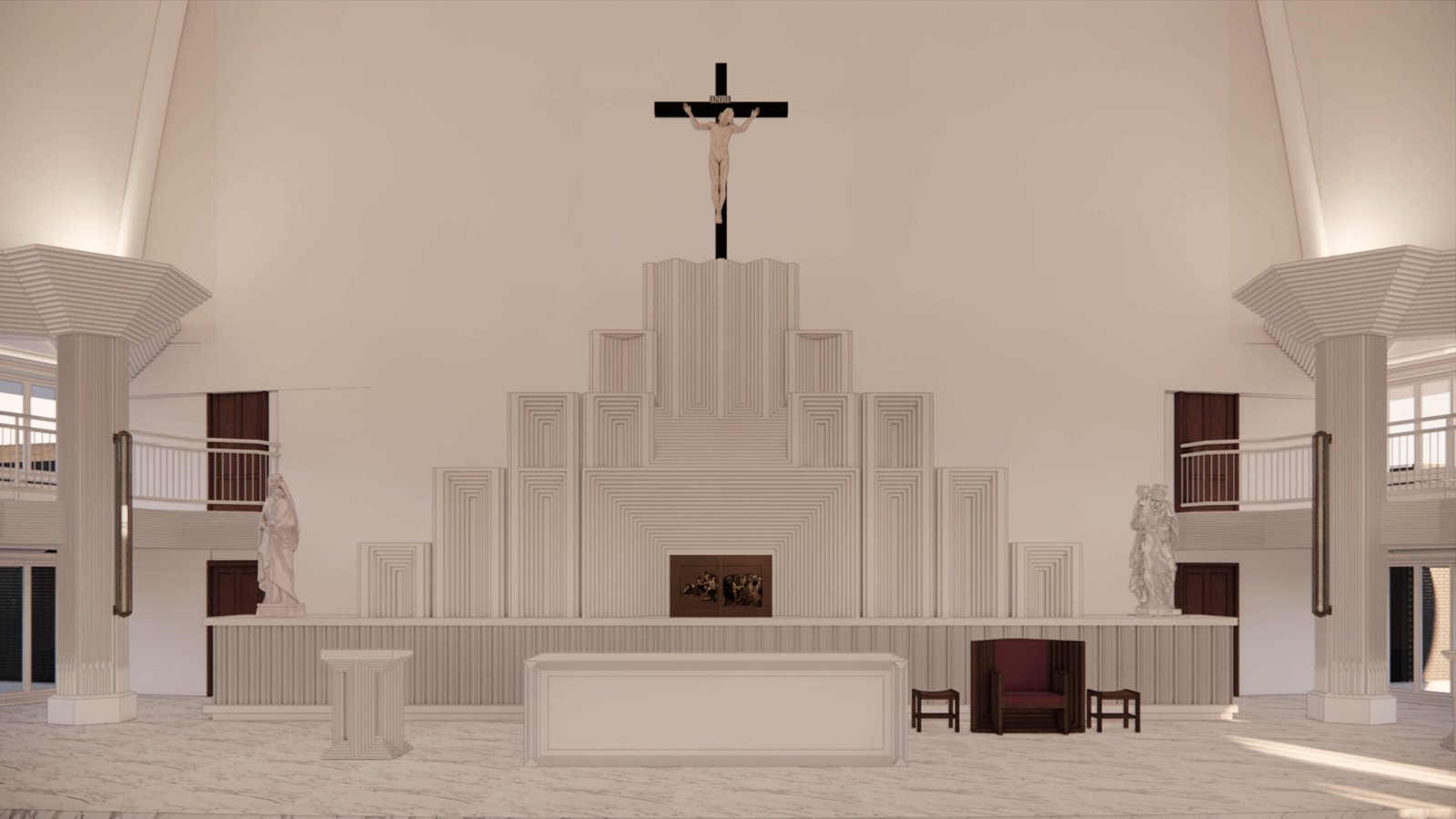



Challenges and Adaptations
And time, indeed, was given Galicia. The pandemic and the country’s extended lockdowns took the project to a standstill for a year. And when construction was finally allowed, pandemic-related price escalations necessitated significant design changes for the church to adhere to budget limits. In response, the team engaged in value engineering and made unforeseen discoveries during site visits.
Robert de Mesa recounts: “One pivotal decision was to remove the side aisle ceiling, increasing vertical space and exposing the triangular structural framework supporting the mezzanine and roof. This decision eliminated the need for noisy jet fans and revealed the full grandeur of the ceiling fins, showcasing their folding form and curvature.”
These and other adjustments were crucial in refining the final design and achieving cost savings amidst evolving project challenges.
Structural Intricacy
The ceiling and skylight reveal a complex network of trusses and supports, demonstrating the engineering prowess of MACRO Consulting Structural Engineers, led by its principal engineer, Ronald Santiago.
“Evo City Church’s design presented several technical hurdles, particularly regarding the structural integrity of the roof and ceiling and the integration of intricate architectural elements,” De Mesa notes. “Modelling the roof structure and ceiling proved challenging due to their double curvature, both horizontally and vertically. Each fin’s structure originates from a triangular plan and tapers as it converges towards the top. Given the complexity of the form, roof height, and exposure to natural forces, our approach was to support it with a space truss system. This system offered a lightweight, flexible solution capable of withstanding various forces while accommodating the structure’s unique design.”
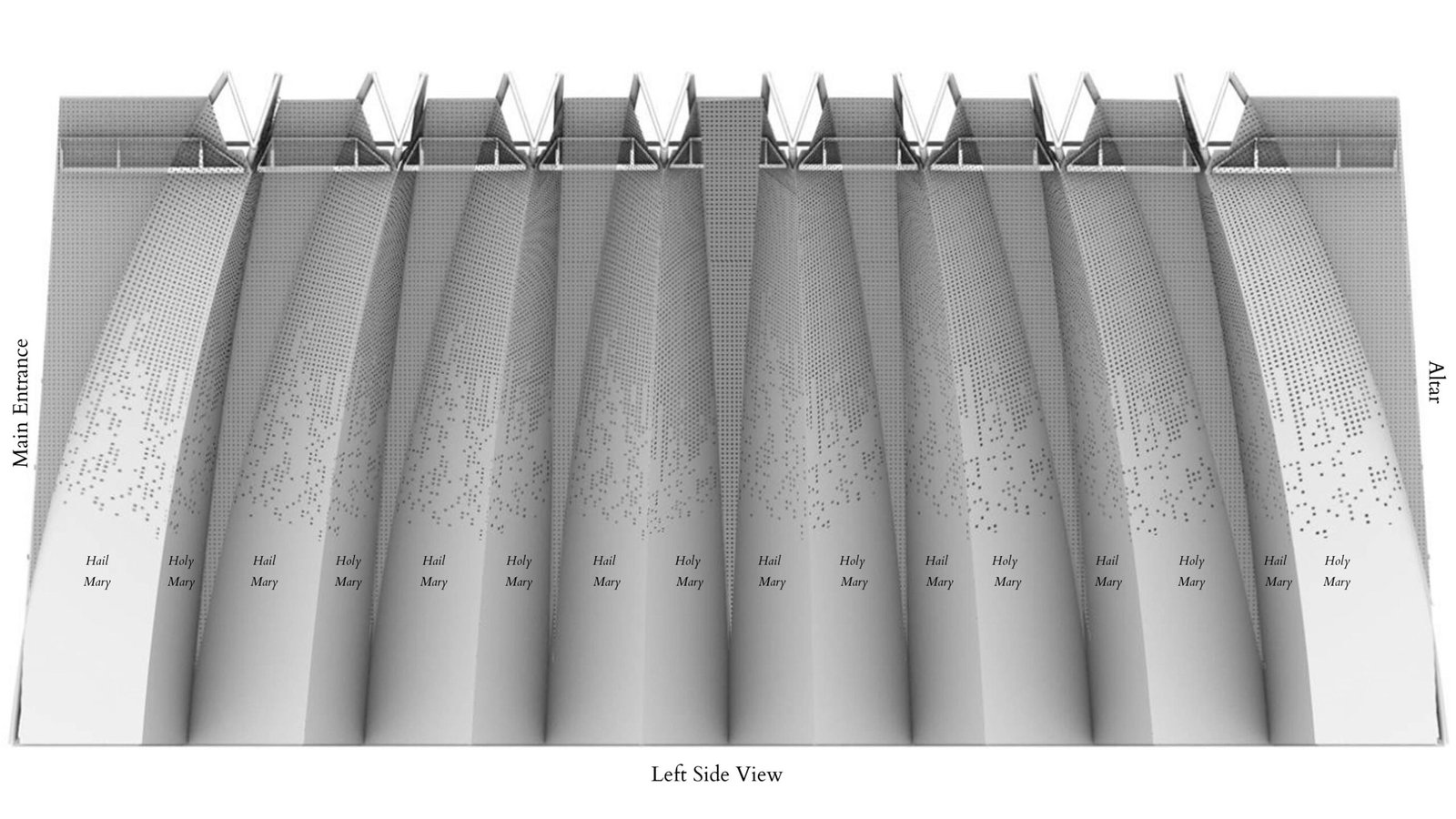

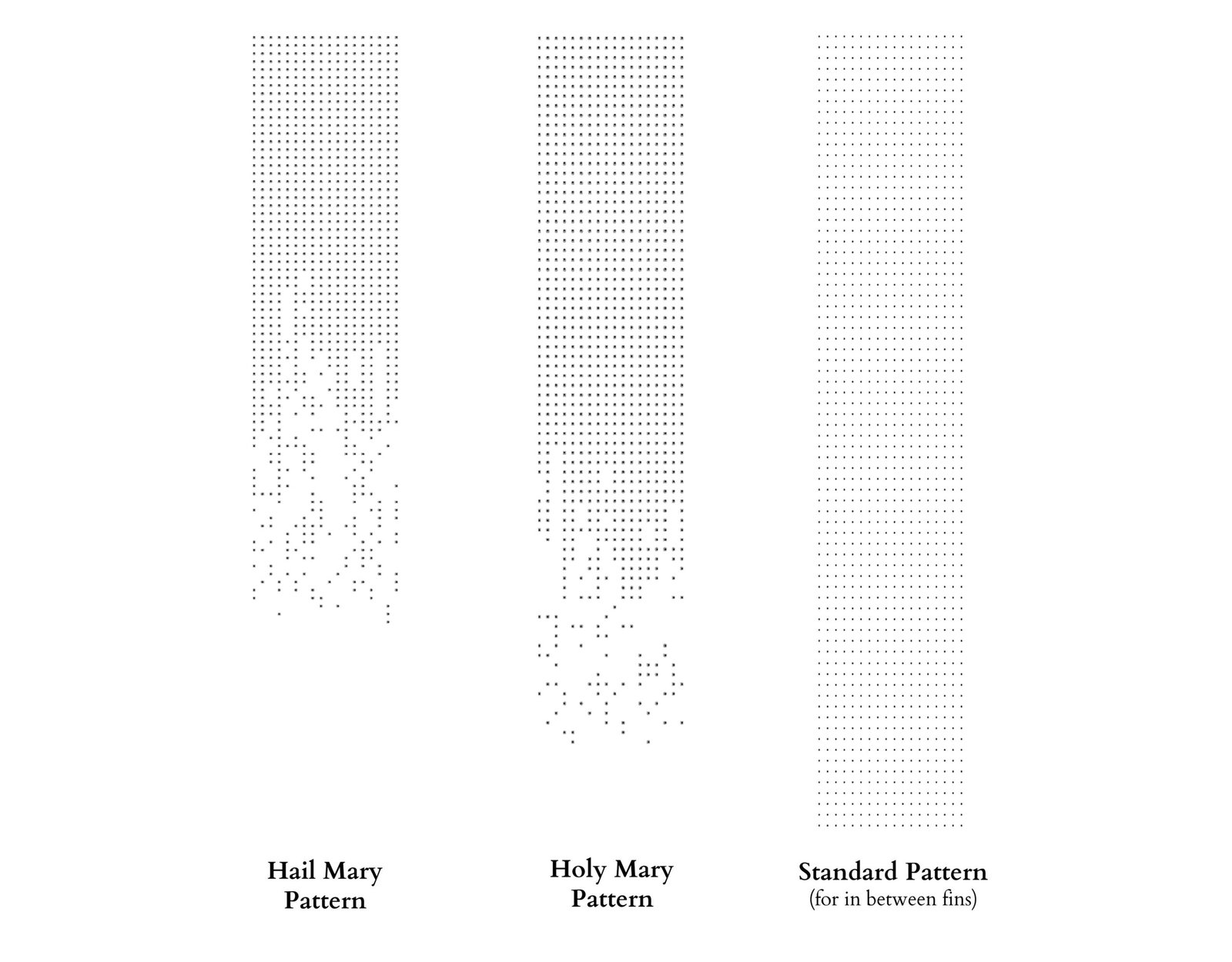

The Role of House of Precast
House of Precast, established 75 years ago, has been a key player in shaping some of the Philippines’ most iconic structures, including the Immaculate Conception Cathedral of Cubao, Ayala Triangle Gardens, and St. Benedict Church, Ayala Westgrove Heights, Silang, Cavite.
“We came on board in May 2023,” shares General Manager Martin Galan. “Dominic Galicia and team are a welcome challenge and inspiration. His vision inspires, and knowing his design elements carry depth and meaning, ours is a task we gladly take on. We turn visions into reality. His attention to detail keeps us on our toes.”
Galan elaborates on their collaborative process: “Having worked with them over the years, they are familiar with the potential and limits of our products. Plans and elevations are sent to us to see if their architectural precast designs are feasible. For the Evo City Church, we are providing columns, a portal, a retablo, horizontal and vertical moldings, and the ceiling. We examine and work out every technical detail, from the attachment points to the structural members of the church to the very shade and finish of the GFRC skin.”
The partnership between House of Precast and Galicia’s team is dynamic and interactive: “Features are sometimes added or deleted for aesthetic reasons, to enhance other church features, or to adapt to actual site conditions,” Galan explains. Once the shop drawings are approved, we begin making the models in plaster of Paris. The architects, owners, and relevant parties then approve the full-sized model before we proceed to mold production.”
Choosing glass fiber reinforced concrete or GFRC for this project was a strategic decision. Its lightweight properties and versatility make it ideal for transport, handling, and installation, reducing stress on the supporting structure and making the project more economical.
The Sanctuary and the Retablo
Moving to the east end of the church, Galicia elaborates on the symbolic elements of the sanctuary. “When the project first came to us, we didn’t know it would be dedicated to Our Lady of Mount Carmel. However, it was 2017, the hundredth anniversary of Fatima, and that influenced our initial design ideas on the relationship between prayer and fulfillment embodied in the design.”
He continues, “At Fatima, Mary said, ‘Pray the rosary.’ So, facing West, we have the Rosary symbolizing prayer; facing East, the crucifix and the stained glass window represent the glory of the Father, the Son, and the Holy Spirit.”
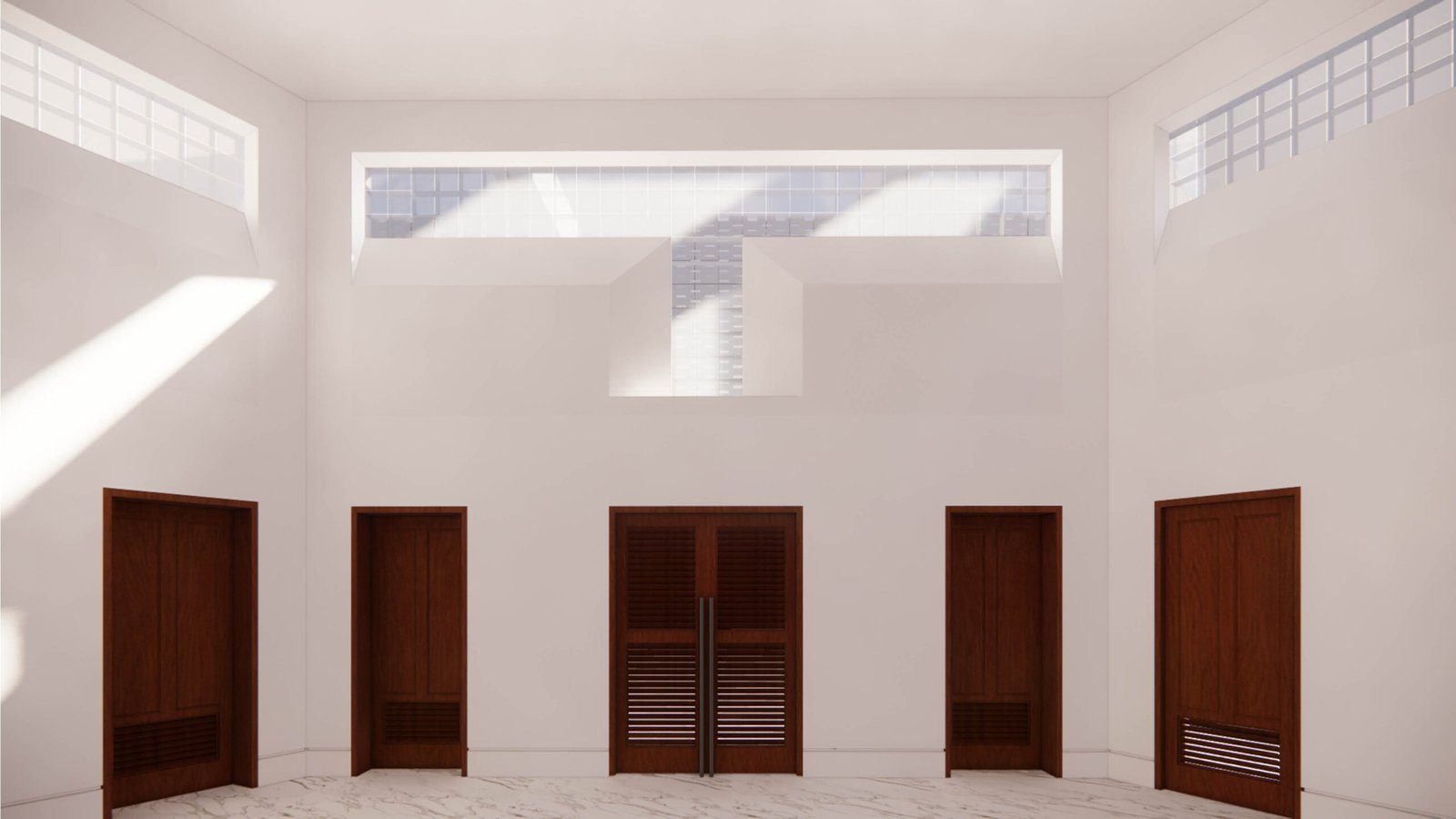



The Retablo’s Symbolism
Galicia gestures towards the east wall, where House of Precast will install a stepped retablo. “Our original design for the retablo had been accepted by the client before the pandemic; however, as the project evolved, we found it too generic, too general in its expression of boisterous glory,” he explains.
Galicia harks to the importance of time in the design process: “The thing about time is it gives you specificity. We wanted something more specific. With its sense of ascent, the current design resembles a mountain and ties into the vision the landowners, Alveo’s co-developers, had for Mount Carmel.”
The retablo, or reredos, traditionally serves as an ornamental backdrop behind an altar, often featuring intricate carvings, sculptures, and paintings depicting religious scenes. These elements are designed to enhance the spiritual experience of worshippers and serve as a form of catechism, reminding churchgoers of biblical and church stories. Galicia’s stepped, Carlo-Scarpa-esque design brings a modern interpretation to this ancient architectural feature, combining tradition with contemporary aesthetics.
The Ark of the Covenant and the Tabernacle
The notion of Mount Carmel is significant in its connection with the Ark of the Covenant. In Christian theology, particularly in Roman Catholic tradition, Mary is regarded as the new Ark of the Covenant. Early Church Fathers introduced this concept by drawing parallels between the Ark, which carried the presence of God in the Old Testament, and Mary, who bore Jesus Christ. The Litany of Loreto venerates Mary with various titles, such as Gate of Heaven, Mother Most Admirable, and Mother Undefiled. These titles are inscribed in the GFRC around the retablo, guiding the faithful towards the Ark of the Covenant.
Today, the tabernacle in Catholic churches symbolizes the Ark of the Covenant, as it houses the Eucharist—the body of Christ. Galicia emphasizes that Evo City’s tabernacle design dimensions are based on the biblical Ark of the Covenant. It will feature two leaves, depicting the Old Testament account of manna from heaven and Jesus’ Last Supper in the New Testament. These images, rendered in bas-relief on brass or bronze doors, demonstrate how an event in the Old Testament prefigures an event in the New Testament. Together, they symbolize the fulfillment of God’s promise.
The biblical Ark of the Covenant was a sacred chest made of acacia wood and overlaid with gold. Measuring approximately 45 inches long, 27 inches wide, and 27 inches high, it housed the Ten Commandments, Aaron’s rod, and a pot of manna. This sacred relic symbolized God’s presence and covenant with Israel. Similarly, the tabernacle in modern churches represents God’s presence, connecting ancient traditions with contemporary worship.
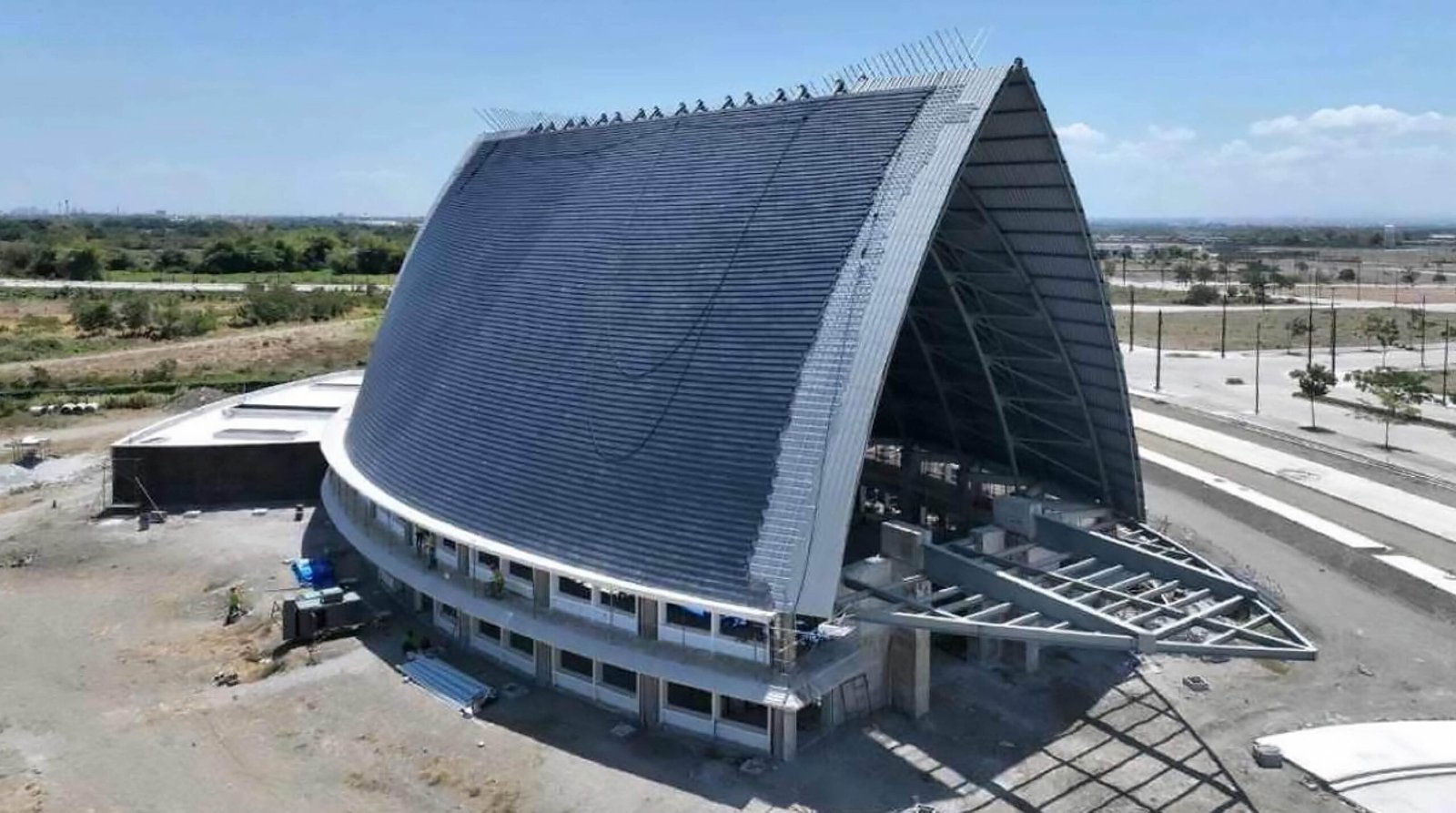



Light as Divine Presence
For a moment, our little group gazes quietly at the expanse before us, absorbing its openness and reverence. Looking up, Christine Sicangco, the project’s principal lighting designer, calls out, “Oh wow, the lumière!” It is her first time seeing the 40-meter-long skylight in person.
“The interplay of light is crucial,” Galicia says. “The way that light enters the interior space in different ways, through different apertures, conveys different things, different meanings, but it is all the same light, all from the same source.”
As the sun moves across the sky, light entering the church transforms the interior atmosphere throughout the day. The western wall, punctuated with clear prismatic glass rosary beads (six inches in diameter for the small beads and nine inches for the large), will capture sunlight, producing a spectrum of colors that change with the time of day. This prismatic light from the West contrasts with the colored light from the East, where stained glass above the altar will glow with changing hues.
Sicangco and her partner, lighting designer and electrical engineer Jo Vincent T. Gonzaga, join our construction site tour. “Our goal is to use light to enhance the church’s stunning architecture and sacred atmosphere,” Sicangco shares. “We aim to create subtle illumination that elevates the spiritual experience while providing practical lighting for reading and wayfinding. With the church’s towering ceiling, we opted for sustainable, easy-to-maintain, efficient, and discreet lighting.”
This is Christine Sicangco Lighting Design Inc. (CSLDI)’s first time working with Galicia, and they are impressed with the firm’s meticulous approach. “They think of everything!” she exclaims. “The relationship and intersection of the vesica piscis and the Rosary is a central theme in the design. Our creative efforts focused on the main entrance door, where the shape of the light as it falls on the door reinforces this theme.”
One particular challenge preoccupied CSLDI: Galicia wanted the entrance canopy to look like a “eucharistic mantle floating above” without the lights calling attention to themselves. After much mulling, the CSLDI team found an answer. “Thankfully, we have come up with a solution that Dom likes!” Right after our tour, they excitedly shared the news with Galicia.


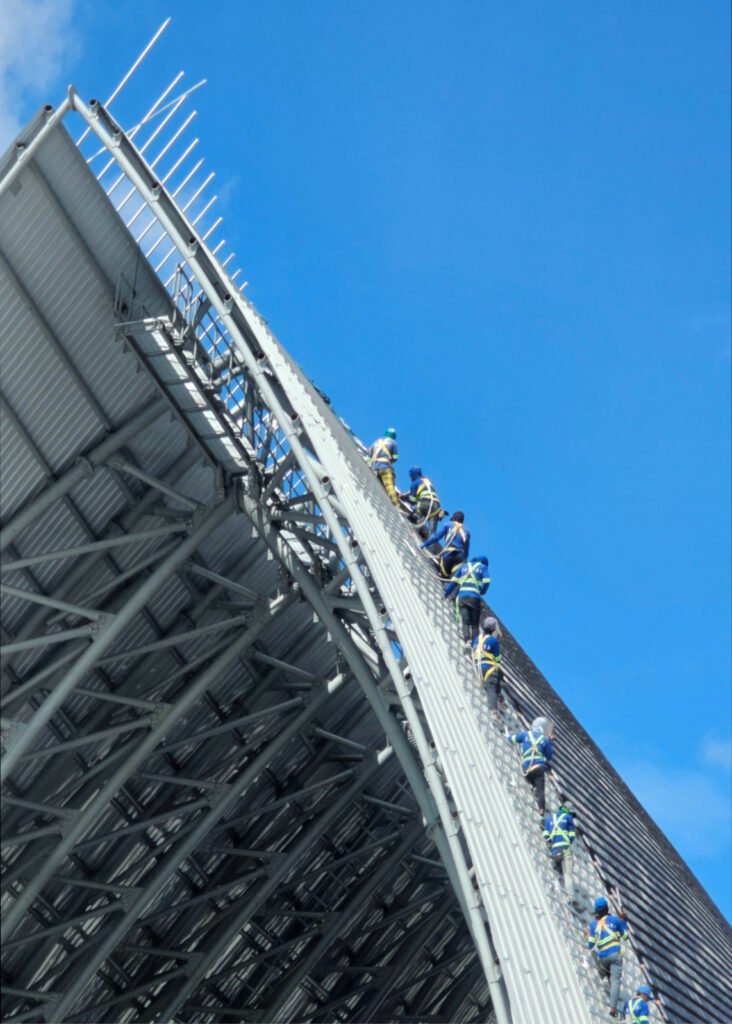
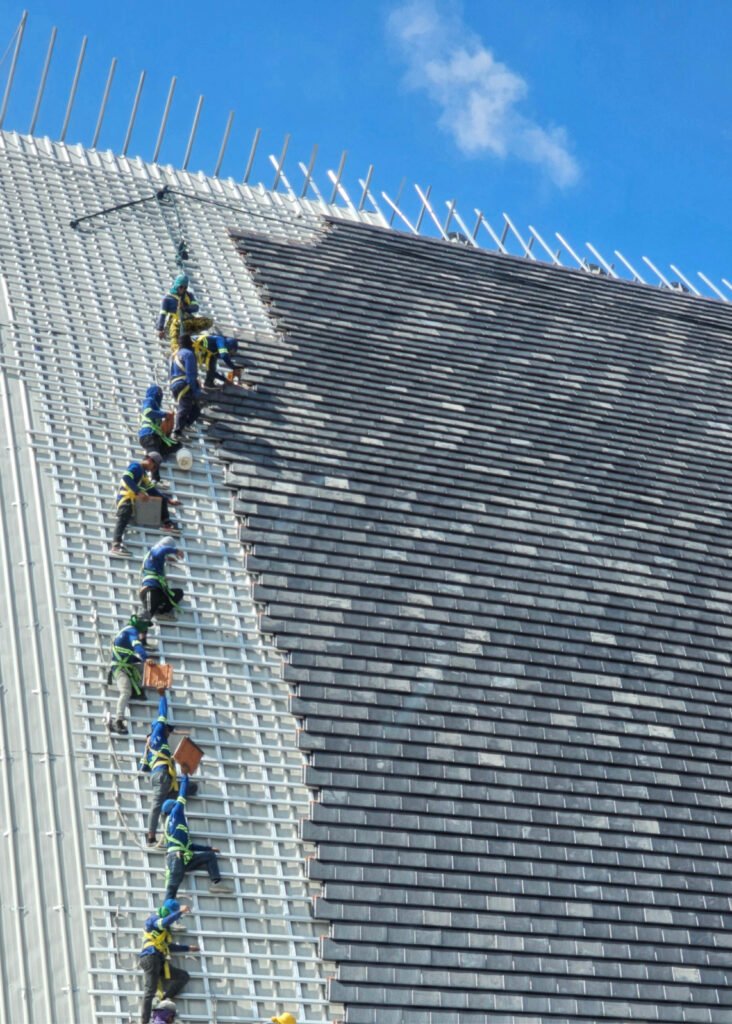

The Role of Acoustics in Evo City Church
Just as important as light in a congregation space is sound. However, it’s a sad truth that few churches consult acoustics experts until after the building is erected. “Centuries ago, churches were designed with acoustics in mind,” explains acoustic engineer and Acoustic Analysis partner Jiggs Hermano. “Pillars, arches, vaults, moldings, sculptures—gargoyles and such—and all these intricate surfaces in Romanesque, Gothic, and Baroque churches broke the path of sound waves, preventing them from traveling uninterrupted across large spaces, creating excess reverberation and echoes.”
Modern churches, however, feature minimalist designs with flat surfaces that sound waves bounce off of and echo, making speech unintelligible.
“The primary goal for church acoustics is to ensure clarity and intelligibility of speech while also providing an environment that enhances music—and the music must be glorioso!” Hermano exclaims. “But in acoustics, the design requirement for speech is the complete opposite for music. You want a very short reverberation time for speech, whereas for music, you want a very long one. We would have no problem if we were designing an auditorium, no? But we’re not. This is a church, and churches are expected to look and feel a certain way.”
One of the main challenges Hermano mentions is hiding speakers from view while ensuring they are placed optimally for sound distribution. “In previous projects, we successfully integrated speakers into the column design because we were consulted before construction,” he says. “Attaching speakers to the columns was a point of contention in this project due to aesthetic preferences.”
Fortunately, says Hermano, “Galicia’s designs often incorporate intricate surfaces that help diffuse sound, thus enhancing the acoustics naturally. The church’s ceiling design, with its deep troughs (Galicia and House of Precast refer to them as “fins”), is effective for sound diffusion.”
Still, Hermano told Galicia and De Mesa they needed additional “sound absorption to cut the reverberation down some more.” He advised them to perforate areas of the ceiling for sound to pass through and not bounce back. “I don’t know what Dom was smoking,” Hermano jokes, “I just asked for holes. But Dom, he designed perforations with meaning!”
De Mesa explains: “After Acoustic Analysis provided the perforation guidelines, we experimented with various patterns. At first, the patterns appeared as dark patches on the fins and didn’t go well with the overall design. To address this, we lowered the patterns and found inspiration from the Rosary, a key motif for the church. Dom suggested using Morse Code to encode “Hail Mary” on one side of the fin and “Holy Mary” on the other. Each line would have different lengths, seamlessly integrating the perforations into the architectural form of the fins.”
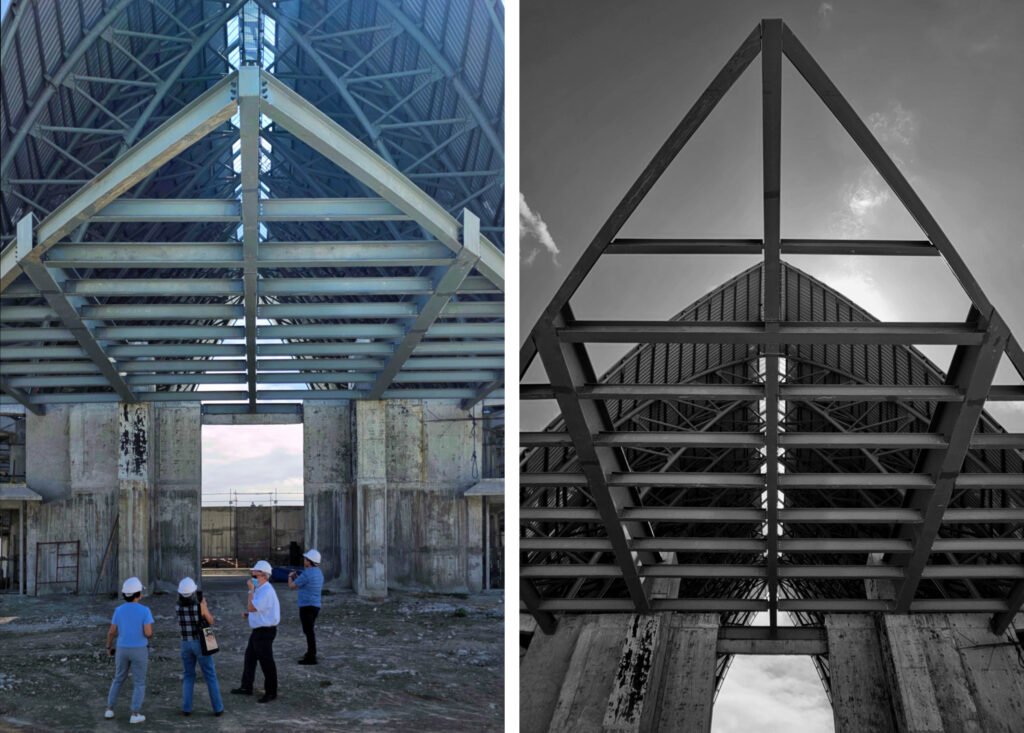





Conclusion: A Space for Contemplation and Community
As our tour concludes, architect Albert Dacumos of the contracting company, FADZ Construction Inc., shares with the group that Alveo wants the church ready by December so that the Diocese of Imus can celebrate Simbang Gabi and Christmas Eve masses.
To follow next year will be the 31-meter-tall carillon tower, complete with a set of bells from the Netherlands.
As the Evo City Church progresses toward completion, it stands as a testament to the meticulous craftsmanship and profound care envisioned by its creators. As with every good and earnest plan, we hope it comes to fruition to embody the hopes and dreams of the community it will serve. May it be a beacon of faith and fulfillment, reflecting the promise of prayer and the journey toward its realization. •









